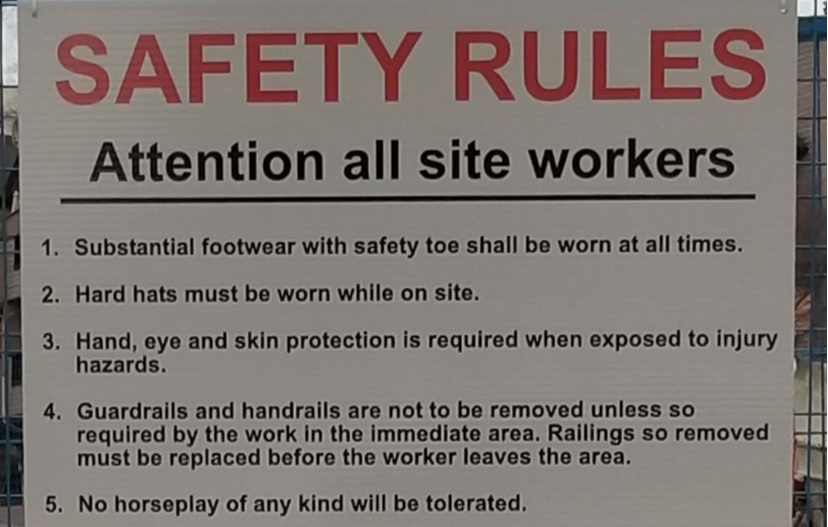Signage is one way of Promoting a Safe and Respectful Workplace
With the new year comes resolutions: ways we can change and improve. That can apply to your workplace safety, both physically and emotionally. You have done a lot of work around building policies and procedures, so now take a good look around you. How visible are the respectful values you have adopted? Do you have signage that communicates effectively?
What do your policies and procedures on respectful behavior look like when you walk around your workplace?
Read the Signage Man!
The other day a friend of mine was telling me a story about a chap he had seen working in a construction site.
It was a weekend and the place was completely empty of workers, even locked down with a secure six foot fence around the perimeter.
The man had arrived at the closed-off site to refuel the diesel tank of a large pump situated within. My friend saw him unlock the gate, enter through the access point he had created, and then get on with his refuelling work.
My friend also noticed that he wasn’t wearing any personal protective equipment whilst he was working. Becoming worried for his safety, he decided to approach the man to voice his concerns.
As my friend walked over, he was greeted by a prominent sign strapped to the gate (about five feet high by four feet wide!). You’ve probably seen similar signs at every construction site: reminders of standard safety rules that everyone must follow.
These large signs are designed to set a general code of conduct that applies to everyone at all times—not just when there are other workers present. The idea is also to encourage workers to hold each other accountable if they see any concerning behaviour.
Furthermore, the sign is legally required as part of the work site’s safety policies and procedures. But unfortunately, it doesn’t stop potentially unsafe behaviour on the weekend—when no one else is there to see.
I know we don’t all work in places as potentially dangerous as construction sites, but that’s no excuse to avoid safety precautions.
Signage in Your Workplace
So, let’s consider your workplace for a moment:
- Do you have policies and procedures in place to promote a safe and respectful workplace?
- Do you have a sign on the wall?
- Do you talk about respectful behaviour in staff meetings?
- Do staff hold each other accountable for safe and respectful behaviour?
- Is it demonstrated when no one else is looking?
As we’ve learned from my friend’s story, this last question is especially crucial.
Taking Responsibility for How We Behave
C.S. Lewis is often credited with the quote, “Integrity is doing the right thing, even when no one is watching.”
And to piggy back on that, I believe that how we respect ourselves is often indicative of how we will treat other people.
Civility and respect thrive in a work environment where we are considerate in all of our interactions—not just with clients or customers, but with each other as well.
And our behaviour should not change depending on the audience (even if there is no audience to witness).
Respect in the Workplace
If you’re still not convinced, a respectful workplace is proven to be connected to:
- greater job satisfaction
- greater perceptions of fairness
- more positive attitudes
- improved morale
- better teamwork
- greater interest in personal development
- engagement in problem resolution
- enhanced supervisor-staff relationships, and
- a reduction in sick leave and turnover
Who wouldn’t want that?
This attitude towards civil and respectful behaviour is not simply a belief that one holds and doesn’t show or share with anyone else.
You can tell who is civil and respectful by watching and listening to them during the day.
Think about workers at a construction site.
Can you tell who is focused on safety—not just their own safety but the safety of others as well?
As we can see with my friend’s anecdote, yes you can.
Luckily, we have regulations in place to help organizations maintain safe and respectful work environments.
Respect and Mental Health
In 2013, the Mental Health Commission of Canada (MHCC) and CSA Group officially released Canada’s first national standard. It was and is designed to improve the psychological health and safety of workplaces, by focusing on how everyone treats each other.
This document also speaks to the importance of having a clear commitment from the leadership of an organization.
Additionally, it encourages education, awareness, and communication—not just once during an onboarding or orientation event, but continually, to ensure that the message is delivered and received.
After all, can you imagine getting on a plane where the flight attendants DON’T go through the safety protocols? What would you think about that airline’s commitment to passenger safety?
We can’t just hang up a large sign on a fence and expect everyone to comply.
We must ensure that what’s written on the sign is demonstrated in everyone’s behaviour at all times.
Even when they are in the office on their own.
If you’re in a workplace where this is lacking, get the ball rolling by being a role model.
We all know how contagious attitudes can be…






